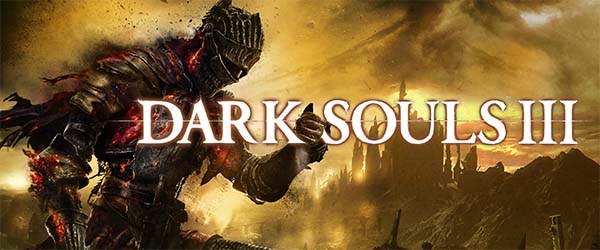
Dark Souls III has a lot of problems. Some of them are surprisingly severe, and could urgently do with some fixing. I'd like to take some time to point out some of the areas of the game that I think could use some improvement.
Table of Contents
What the hell does poise do?!!
In my review, I noted that poise seemed to have been turned off in the game's code. Well, FROM Soft has apparently stated that poise is working as intended. Really? How? What does it do? FROM was not forthcoming (so far) with any details on what the stat is supposed to actually do, other than to say that it is "more situational". Ok, whatever. So I guess it's up to the community to try to figure out how this stat apparently works, since it doesn't work in any way comparable to the previous games, nor does it seem to solve the problem that the original implementation of poise was intended to solve.
UPDATE Nov 16, 2016:
It looks like we've finally figured out what Poise does in Dark Souls III. It seems to only be activated when using large weapons that provide Hyper Armor.
I had previously believed that Poise functioned as an "escape method" from quick, stun-locking weapons (like daggers). My early interpretation of Poise was that a higher Poise value may allow the player to escape from a stun lock and be able to roll / counter-attack / parry after 3 hits rather than 5 or 6 consecutive hits. I even remember testing this hypothesis out and finding it to hold true. This would also apply to situations in which a player gets attacks from multiple enemies simultaneously (or in quick succession). Higher Poise would allow you to escape from the 3rd enemy's attack, rather than the 4th or 5th. But according to the Wiki, this doesn't seem to be the case. Am I wrong?
If it is true that Poise only affects Hyper Armor, then I'm still not happy with the mechanic, as it only applies to very specific builds, and might as well be a stat on the weapon rather than a feature of armor. But if it does also affect the ability to escape stun locks, then I guess I would be a little bit more satisfied.
Poise was originally intended to act as a counter to extremely fast weapons like daggers, rapiers, and so on, that could quickly hit and stagger an opponent and put them in a stun lock from which they couldn't escape (so long as the attacker still had stamina). It was also intended to give players with slower weapons an opportunity to tank their way through hits with such fast weapons. You'd still take damage, but assuming your attack with a stronger, slower weapon did more damage than your opponent's weaker, faster weapons, then the trade-off would still be in your favor. If you were going to use a very slow weapon, then it behooved you to also equip heavy armor and other poise-boosting equipment so that you could tank through opponents' hits. That doesn't seem to be the case anymore. A knight in full heavy armor should not get stun locked in a 10-hit combo from a dagger. It simply shouldn't happen. This is what poise was designed to prevent, and it's not doing its job. If an invader shows up in your world with an estoc, and you aren't an expert at parrying, then you might as well just offer up your head on the chopping block and get it over with.
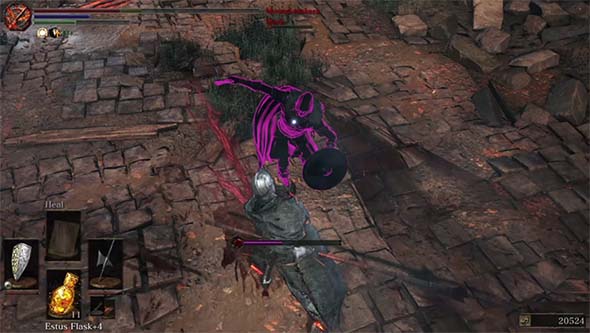
Without poise, heavy armor is worthless, and daggers are incredibly overpowered against slower combatants.
Without poise in this form, heavy armor simply isn't worth its weight encumbrance, especially since you can't even upgrade it to increase its damage resistance. This was a problem in Demon's Souls, which didn't have poise. Heavy armors generally didn't reduce damage enough to be worthwhile, they prevented the player from effectively rolling, and they were so heavy that they prevented the player from being able to pick up all the loot in a level because that game also had an item burden. Rolling was the end-all-be-all of defense in Demon's Souls, and that was one of the game's greatest weaknesses. It was easy to overlook because the developers didn't know better at the time. But they do know better now. Was poise exploitable in Dark Souls? Sure. It was really exploitable in Dark Souls II due to its connection to hyper armor and the inclusion of farmable healing items. But whatever FROM Soft did to it in DSIII seems like a severe overreaction.
Once I learned that poise wasn't working the way I expected it to, I gave up on trying to engage a lot of enemies with my slow halberd. Instead, I started fighting the knights in Lothric Castle and the Grand Archives with my flame-infused barbed straight sword - which I also spent a bunch of titanite to fully upgrade. This speedier weapon allowed me to attack these knights as fast (or faster) than they could attack me, giving me enough of an edge to reliably beat them. The ones with the tower shields and lances still gave me trouble, but the swordsmen fell swiftly to my +10 Barbed Flame Sword. Even Yahtzee noted in his Zero Punctuation review the starting long sword seemed better than any of the numerous boss weapons that he found. I imagine that this is because he also had trouble with the lack of poise, but didn't quite figure out that poise wasn't working.
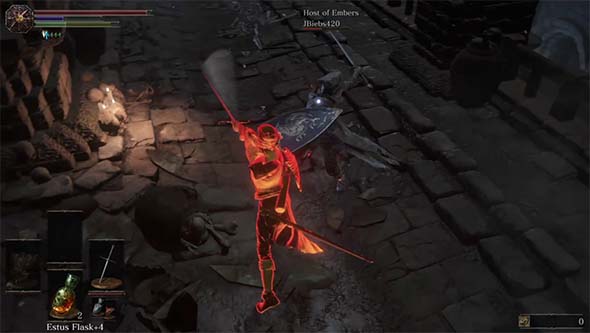
Lack of proper poise allows the estoc's reach and speed to make it a deadly PvP weapon.
So this leaves us with the question of "what, exactly, is poise intended to do?". Is it something that only affects hyper armor? If so, then it's only useful in very rare circumstances, and only with a select handful of weapons. Some have speculated that poise probably operates similarly to agility in Dark Souls II. That would mean that it potentially affects the number of i-frames in a character's rolling animation. If that's ture, then poise is garbage! I didn't much care for the agility stat in Dark Souls II because of how it disassociated the i-frames from the rolling animation. The same problem would be true with poise in Dark Souls III. What's worse is that mapping poise to roll i-frames is completely counter-productive, since poise is granted from the very same heavy armors that often burden characters over the 70% threshold that results in fat rolling. So rolling shouldn't be a major component of those characters' play-styles. Standing firm and tanking hits is what they need, and that's not what poise allows them to do.
I don't think this is what poise is doing though, because there's the Carthus Bloodring, which has the effect of "boosts rolling invincibility, at the cost of defense". It doesn't say that it boosts poise, nor does it add to the poise stat. So I'm going to shoot down the idea of poise acting like agility in Dark Souls III.
"Ring worn by warriors of the sand kingdom, Carthus.
Boosts rolling invincibility, at the cost of defense.
The sword technique of Carthus allows for fluid movement with a curved sword. Masters of the technique are said to dazzle their opponents by moving as weightlessly as a grain of sand. They live for their High Lord Wolnir, conqueror of most kingdoms known to their people."
Even if the developers fear that poise will imbalance the game further in favor of light or heavy weapons, or that it will encourage poor play, then the stat should still do something that is demonstrably useful. That could be reducing damage taken from critical attacks, reducing damage while blocking, or some other effect to mitigate the threat of mobs. But it needs to do something.
At the time of this writing, this is still an open issue within the community, and it needs to be resolved.
Show the entire upgrade path for weapons
I doubt that an interface change as big as this could happen, but I would really like to be able to see the entire upgrade tree for weapons right from the start; or at the very least, show what the max (+10) attributes will be. Being able to see what the +10 version of the weapon will look like with regard to attribute bonuses and attack power would be invaluable in determining which weapons you want to invest in to upgrade. It's not really a deal-breaker, but knowing in advance if a weapon's attribute scaling will change would definitely help prevent a player from having to waste time grinding for souls and upgrade stones if they discover that a different weapon ends up with better scaling.
This can also come in handy for certain weapons that start out with balanced scaling, such as straight swords, halberds, and some other weapons. A weapon that starts with C-C or D-D scaling in Strength and Dex can end up staying middle-of-the-road, or it might eventually diverge one way or another. The Red-Hilted Halberd, for example starts out with pretty bland D-D scaling. With upgrades, it eventually stats to scale better with Dex, but it takes a long time before making that shift. This caught me a little off guard, because I was used to using halberds in Dark Souls II, which scaled better with strength, and I'd been focusing on strength as my primary attack attribute with that particular character. I probably should have expected this, since the halberd in the first Dark Souls had a similar scaling progression, and the halberd in general behaves more like it did in the first Dark Souls.
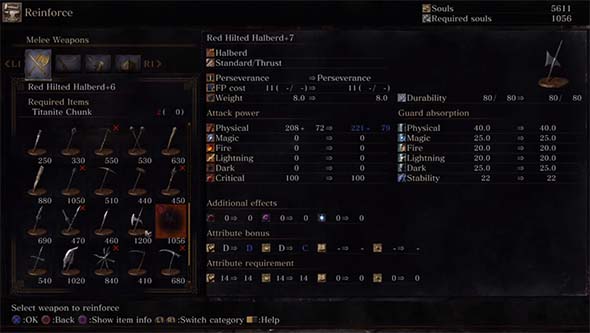
I wish I would have known in advance that this halberd would eventually scale better with Dex...
There's similar issues with some other weapons. Wolnir's Holy Sword starts out with basic D-D scaling, but turns to D-C at +2. You'd think a greatsword would have better strength scaling, but not in this case. You'd also think that a "holy sword" would have some faith scaling or requirement, but again, that isn't the case. The Irithyll Straight Sword goes the opposite direction by starting at D-D and then upgrading to C-D at +2, despite being a "straight sword" which usually favor dex. Even more confusing is that the Profaned Greatsword starts out with C-D scaling favorable to strength, but then switches to a more ambiguous C-C scaling at +2.
In any case, any confusion with regard to such weapons' scaling could have been entirely avoided if the game would just show the upgraded stats to the player. Just make an extra screen that you can toggle to in addition to the regular item description screen. That extra screen can show the weapon's attack power and scaling at each upgrade level, or show the full +10 stats for each of the weapon's available infusions.
Filter Soul Transposition list by boss soul requirement
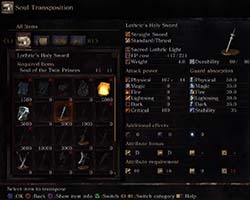
Weapons should be filtered by the
soul required to transpose it.
And while we're on the topic of weapons and upgrades: most transposable souls make multiple items available for purchase. Trying to compare those items can be a bit a pain though, since the items for sale are sorted and filtered based on their type. So if you're trying to decide between which of two (or more) mutually-exclusive transpositions to buy in this particular game cycle, you have to pass through multiple irrelevant items while comparing the stats, requirements, scalings, or descriptions of the items. This only gets worse as you defeat more bosses and acquire more transposable souls because it's just more items to skip past when navigating to the one(s) you want to view.
If items from the same transposition soul could be grouped together, you could quickly and easily identify your available options and compare the items. This shouldn't necessarily replace the existing filtering or sorting options, but it would probably be the more useful option. Being able to use the trigger buttons to filter between "Soul Required" tabs could be a good way of accomplishing this, as it leaves the current filtering mechanisms in-tact. These buttons are completely unused (as far as I can tell) while the player is in the menu anyway.
Show all the players equipment
This one isn't quite a big deal, but it's something that I've had on my wishlist for some time. I'd like to be able to see all of a character's current equipped gear on the character model. This would allow players to see each other's backup weapons. In addition to being a handy reference for your own current equipment loadout, this would come in handy for multiplayer. You'd be able to see what weapons a cooperator or invader has equipped, and would be better able to judge that character's capabilities.
Admittedly, with three item slots for each hand, such a feature could make the character models quite busy indeed, and it might not be practical. In any case, I'm still going to throw it out there because I do feel that it's a proposal that has some value.
This could be achieved by enforcing rules regarding the difference between "main weapons" and side arms. Perhaps the first inventory slot in each hand could be dedicated to a primary weapon, which could be anything ranging from a bow to a dagger to a shortsword to a halberd to an ultra greatsword. The remaining two slots on each hand could be reserved for side arms - smaller weapons that can be sheathed at the hip. Side arms would include crossbows, short swords, rapiers, daggers, and so on. This might not be desirable for many players, as it would limit potential character loadouts and player expression. Personally, I'd be OK with such rules, especially if combined with a genuine item burden or other restrictive inventory mechanics. But that all seems incredibly unlikely to happen.
Restrict summons' usage of the Storm Ruler
Yhorm is a very difficult boss to fight directly due to his abnormally high HP. There is a fairly obvious trick to beating him, however, in the form of the Storm Ruler sword. During this battle, the Storm Ruler's chargeable weapon art (the shockwave) costs no FP. This is supposed to make it so that the player can actually have a reasonable chance at using the sword's abilities enough times to actually down the boss. However, this can be exploitative, as this nuance applies to all summoned phantoms as well - and even to Seigward if he shows up in this fight. Having three, four, or even five characters wailing away at Yhorm with Storm Rulers can make this boss trivially easy to fight. Not only does it take large chunks of his HP away, but it also causes stun effects that give players chances to heal. I like to use this boss as an easy way of farming souls, embers, and (often) Sunlight Medals during the later stages of the game, since it's such a simple, low-risk fight (assuming that everybody is equipped with the Storm Ruler).
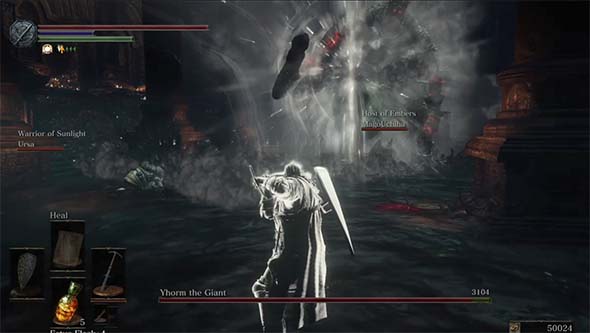
Including Seigward, there can be up to four or five Storm Rulers being used against Yhorm in a single fight.
In order to make this boss less of a pushover (literally), I propose that the ability to use the Storm Ruler's charged weapon art should consume FP as normal for summoned phantoms. This would prevent phantoms from completely wrecking the boss without the host having to even do anything, and it would help make the battle a little bit more challenging. The weapon skill should remain free to the host player (and to Seigward as well). Additionally, the weapon could have stat requirements added to it after Yhorm is defeated, which would prevent many dex, int, or faith-based phantoms from being able to use it. This could be accomplished by a scripted event that changes the weapon's properties; or there could simply be two versions of the Storm Rule, and the one that has no attribute requirements can only be picked up and equipped in the boss's room.
Less arcane NPC quests
Dark Souls III has some of the most complicated and easily-broken NPC questlines in the entire lineup of FROM games. Part of the problem is that some of these questlines intertwine with one another, so that missing one step in one NPCs questline can cause ripple effects that block other NPCs from completing their questlines. NPCs tend to be fairly well hidden after their initial encounters.
The easiest ones to mess up are probably Siegward, Patches, and Grierat, which makes sense because their quests are tied together. In my first playthrough, I completely missed finding Siegward in the Cathedral of the Deep, which meant that I also never found him in Irithyll Dungeon, and he was unable to show up for the boss fight against Yhorm. I also never came across the encounter with Patches in Cathedral of the Deep either. Instead, I didn't meet Patches until I decided to grind some levels for the Dancer of the Boreal Valley by exploring the area that the Firelink Tower Key opened up. So I didn't meet Patches until I was long past his ability to interact with Siegward's quest. This, of course, also lead to a premature death of Grierat.
These characters could probably all use some adjustments to their quests and dialogue.
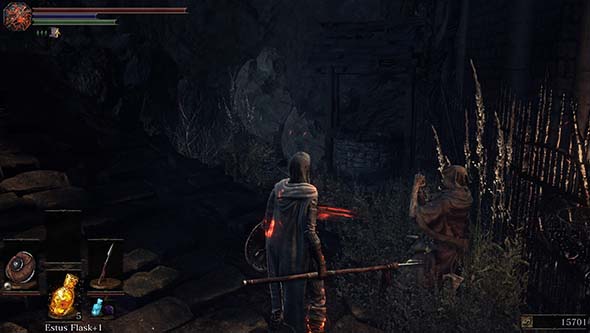
Shifting this enemy closer to the well would ensure that the player triggers Siegward's dialogue.
Siegward is very well hidden within the game for all but his first quest encounter. He gives no indication that he's traveling to Cathedral of the Deep or to the Profaned Capital, which means that the player has no reason to go looking for him in either of these places. Further, he doesn't even appear in the well until you've all but beaten the level and have no reason to go back out to that path. I can't think of any reason why that would need to be the case, so it seems perfectly reasonable that he should appear in the well when the player first arrives in Cathedral of the Deep. Placing an enemy closer to the well outside the Cleansing Chapel would also help, as killing it would bring you close enough to trigger Siegward's dialogue. Patches could maybe provide some indication that someone is trapped in a well in Cathedral of the Deep if he's met within the Cathedral, and that would certainly help with Siegward's quest. Of course, that would also be contingent on the player having encountered Patches in the Cathedral of the Deep, which is apparently also a volatile event that can be easily bugged into not happening.
It's either that, or the game needs to provide some reason to go back outside of the Cleansing Chapel in order to possibly encounter Siegward. An optional boss, a secret area, something, anything! This is a bit of a problem with the design of Dark Souls II, Dark Souls III, and Bloodborne in general. The ability to warp from the beginning of the game means that backtracking is rarely necessary, and so any quests or optional areas that require backtracking are just inherently more difficult to stumble upon. This is one of the greatest strengths of Dark Souls 1's world design: it's tight, compact, and helixal design meant that you had to use shortcuts and backtrack through previously-explored areas. This gave the player reason to re-explore earlier areas, and the opportunity to incidentally run across NPCs, items, or optional areas that they may have missed (though, admittedly, Siegmeyer's appearance in Blighttown was also very easy to miss, since that area was far away from any shortcuts that you might use).
Grierat's quest is fine in principle, but his is one of the ones that has the excessive arcane steps involved. The good news is that the game is up front about the risk associated with Grierat's quests; the problem is that it doesn't provide any information about how or why he is successful and unsuccessful. Some sort of dialogue explaining how he just barely survived by the skin of teeth, or how someone came and saved his life at the last moment would go a long way towards clueing in the player that you need to help other NPCs in order to support Grierat.
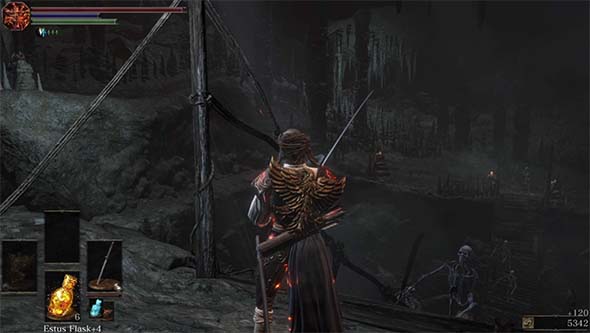
This swarm of skeletons can easily be triggered to force you across the bridge before you talk to Anri.
Anri can have similar problems, since Cathedral of the Deep must be completed in order to unlock an important conversation with her. This is one level that can be completed out of order, and so it's easy to miss her appearance in the catacombs. This seems to be a common theme, since Cathedral of the Deep is a key location for most NPCs. So it seems that they wanted the NPC quests to be this obtuse. But at least she tells you that she's going to Cathedral of the Deep. I would have also preferred that they not place her next to the collapsing rope bridge in the Catacombs, since you'll very likely be running for your life in that place and might not notice her tucked away in the corner. Placing her at the entrance to that cave, or at the far end of the bridge near Wolnir's boss room might be a bit better. However, having her standing right there outside of the boss fog gate, but not be available to help you in the fight might seem weird. The shape-shifting assassin is admittedly a difficult thing to catch unless you see a player's message telling you to attack the statues. But that's what the message system is for, right?
Don't teleport the player from one boss to another!
This is probably the cruelest trick that the game plays on the player. After beating the last of the three Heirs of Cinder, the player is automatically teleported to the cathedral building in High Wall of Lothric, where the old lady gives you a basin and then promptly dies. Once given the basin, if you do virtually anything other than immediately use a Homeward Bone, you'll get stuck in one of the toughest boss fights in the game. Without ever having had a chance to spend the buttload of souls that you'd earned from the previous boss!
"Chalice used in old ceremony in which Lothric knights take their vows.
It is only a formality now, but it remains as an empty practice.
Place this basin at a statue of a beheading knight."
This feels wholely unnecessary. The game could have provided the player with some other message or prompt instructing you to return to High Wall of Lothric and speak to the old woman again. The Fire Keeper could have told you to do this the next time you warp back to Firelink, a dialogue box could have popped up to tell you, a cutscene could have played in which the old lady beckons you to return to her, or an item could have been given to the player with a description that tells you to return to the old woman at High Wall of Lothric. Heck, they could even have just given you the Basin of Vows after beating the third Heir. Its description already tells you what to do with it (though it wouldn't hurt if it were more specific). There's a multitude of ways to have handled this bit of game, and FROM picked possibly one of the worst ways to handle it.
DLC suggestion: The Age of Dark
When preview screenshots started showing the "dark" version of Lothric, I was hoping that Dark Souls III would explore the world during the Age of Dark. My hope was that within the first half of the game, the flame would die (or be deliberately extinguished), and the rest of the game would take place during the onset of the Age of Dark. This is a component of the game's lore that has never really been explored.
If I'd have designed this game, I'd have had the player defeat the four lords and go to the Kiln of the First Flame all in the first half of the game. This game's final boss would be the midpoint of the game, but the flame would not be able to be rekindled (perhaps because Lorian sabotaged it), and the entire second half of the game would take place during the onset of the Age of Dark in which the player finally resolves the undead curse and ends the cycle of cinders.
Heck, I might even have included an optional "Link the Flame" ending that would give you an end credits sequence and an ending trophy, then take you back to New Game +. You just wouldn't play the entire second half of the game.
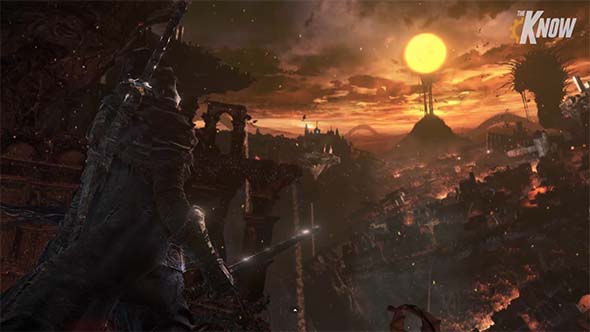
When screenshots like this started appearing, I was excited about the possibility of seeing the Age of Dark.
This didn't happen, and we instead got yet another story about re-kindling the First Flame (or not, as the case may be). Dark Souls II seemed to imply that linking the flame was the canon ending of the first Dark Souls, but there was also the cyclical interpretation that the ending of the first game was moot and that the world would just continue in an endless cycle of light and dark ages. Dark Souls III backtracks on that potential interpretation and makes the linking of the flame absolutely, concretely canon. I feel that this was a mistake, and it limited the freedom and creativity of the developers to try some really new and radical ideas with the series.
Hopefully, the promised DLC later this year will address this. I'm hoping that one of these DLCs will add an entire Age of Dark scenario that explores what would happen to this world if the First Flame were allowed to be extinguished. Of course, I'd rather that this have been the focus of an entire game, but since we're operating under the assumption that Dark Souls III will be the final entry in the series, I guess we'll have to settle for DLC.
Lifegems or Estus from message rating
One of the big weaknesses of Demon's Souls was that you would get resurrected by beating bosses, but then you might take two steps out into the next area and get promptly killed by a dragon, losing your newly-acquired human self and half your health bar. You'd then have to get yourself summoned in order to beat a boss as a phantom in order to get your human body (and half your health bar) back. Dark Souls fixed this by introducing the Humanity item. When you beat a boss, you would be awarded with a Humanity in your inventory, which you could chose to use at any time of your convenience. Dark Souls III maintains this feature with the Ember item.
HP from message rating is rarely useful [LEFT], let alone a life-saver [RIGHT].
There's a similar problem with another of the game's online mechanics: message rating. Leaving helpful messages is supposed to reward the player with some extra HP when it's rated by other players. The problem is that this might happen at inopportune moments - like when your HP is already full, you're sitting at a bonfire, or just after you already used your own Estus. Perhaps this mechanic could use the same solution as the Humanity item from Dark Souls?
This could be a potential avenue for the re-introduction of Lifegems (from Dark Souls II). Personally, I think this is how lifegems should have worked in Dark Souls II, instead of being dropped from enemies or bought from vendors. It's good that Dark Souls III does not have farm-able healing items, and that the player has to be much more conscious about your health. That being said, an item like a lifegem could solve the problem of message rating similar to how the Humanity item solved Demon's Souls problem of being resurrected immediately after defeating a boss. It does, however, re-introduce the problem of Lifegem farming that kind of defeats the purpose of limiting the use of Estus. But at least it ties into an online mechanic and rewards the player for using the game's novel online features. Limiting the number of messages that a character can leave, and restricting message appearance by character level (similar to summoning and invasions) could help limit the ease with which Lifegems could be farmed in this manner, but it's still sketchy from a balance perspective.
Perhaps a better solution would be to award the player with an extra charge of Estus whenever one of their messages are rated. That would fit in with the game's current mechanics better, but would still give the player a bit more flexibility to use the healing when it is most useful to them. The only time it would feel wasted would be if your Estus is already full. In that case, maybe it could even fall back to restoring HP (if possible). Alternatively, having a message rated while your Estus is already full of charges could maybe even be a way of temporarily increasing your max Estus. This should probably only be allowed to happen once so that it does not become exploitable.
A method to the madness
The Mound-Builders covenant is one of the better ideas in this game, and probably the only positive addition that was made to covenants in general. The idea was apparently to add a degree of tension and distrust between hosts and summoned phantoms. Of course, you only need to distrust the purple phantoms, and even then, it's a pretty safe bet that they're probably just going to try to kill you. Unless a red phantom shows, and it's easy for the purple phantom to sit back and wait for you to kill it (or swoop in and kill it himself), it's a near certainty that the purple phantom will turn on you - no matter how helpful they may appear to be at the start. And so it's almost always ideal to just kill them as soon as you get a chance, or just not summon them to begin with. This is because the goal of killing the host or a phantom is a bit too limiting.
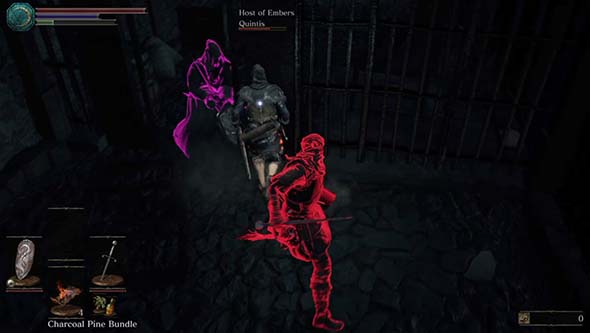
Mad phantoms' motives are rarely as uncertain as the game's designers apparently wanted them to be.
In this case, the purple phantom blocked a doorway until the host or the invader killed each other.
Either way, the purple phantom won.
I think a better system might have been to randomize the goal of the purple phantom at the moment that they enter the host's world. The purple phantom won't know what their objective will be until they are actually summoned and enter the host's world, and the host would remain oblivious to the phantom's goal. These goals could range from benign, to beneficial, to outright malicious. Sure it takes a bit of the freedom away from the mad phantom, but it creates a greater degree of unpredictability for the host and his allies.
Some possible mad phantom goals could include:
- Kill the host or one phantom.
- Acquire [X] amount of souls from defeated enemies (with X being a function of the level you're summoned to).
- Defeat an area boss with the host.
- Maybe even (very rarely) kill an NPC in the host's world?
I'm sure that FROM Soft (or the player community) could probably find some other, more interesting possible objectives for mad phantoms. Something like this makes it more worthwhile to summon purple phantoms because there would be at least a moderate chance that the phantom would prove to be helpful, and would not be required to turn against you at some point.
Cumulative covenants
The other covenants also feel weak. The biggest problem that I have with them is that there's no sense of commitment or permanence to the decision to join a covenant. Being able to switch covenants at the drop of a hat means that these aren't "covenants" by definition, because a "covenant" generally assumes a binding agreement. As I mentioned in my review, the ability to hot-swap covenants seems like it is intended to appease power-gamers who want to be able to level up every covenant with one character in a single playthrough.
I prefer a more mutually-exclusive system of covenants in which your choice of covenant is more tightly ingrained in the character's identity. Such a system requires your covenant choice to be mostly permanent, and so you either need to be prevented from switching covenants, or there needs to be strictly-enforced penalties for abandoning a covenant. The first Dark Souls did this (and Quelana's Chaos covenant is probably the best example), but it was only modestly effective.
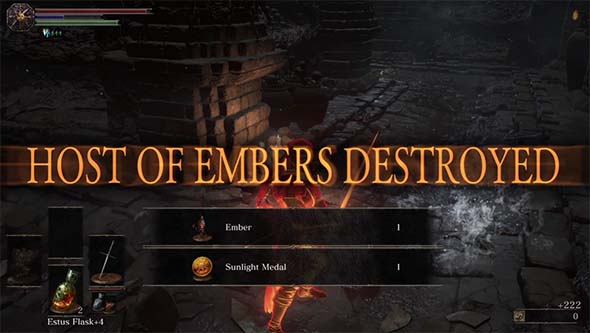
Different multiplayer methods interact differently with covenants. Perhaps covenants could interact with each other?
Another option would be for Dark Souls III to expand its existing mechanics for covenant combinations. Certain covenants behave differently when combined with others. Invading a player while in the Sunlight Warriors spawns you as a golden-red phantom that grants the rewards of both invasion and a Sunlight Medal. The game could have expanded on this idea by making it so that each time you swap covenants, you add the effects of the new covenant onto the accumulated effects of the others, creating a unique set of covenant combinations. You wouldn't ever abandon an old covenant; you'd just add the effects of the new covenant.
This could create a situation in which your character becomes a Mound-building Sunlight Darkmoon (with a unique phantom color). You could be spawned into a world to defend a Way of White member, or kill them, and get a Sunlight Medal either way. A Sunlight Way of White player could award Sunlight Medals to any Blue Sentinels or Darkmoons that come to their defense. Being in both the Sunlight Warriors and the Aldrich Faithful could grant the reward of some kind of unique weapon or spell that has both Lightning and Dark properties. Those are just simple examples. I'd hope that such a system would be more fully-developed with more unique gameplay mechanics, rewards, and covenant interactions. Certain covenants are in opposition to one another (such as the Darkmoon and the Aldrich Faithful), so there would have to be restrictions preventing players from joining both.
An actual sin system and restoration of the Darkmoon covenant
Without any kind of sin mechanic, the anti-invader covenants feel a bit underdeveloped. I miss the sin system from the first Dark Souls that allowed PvPers to also take on the role of bounty hunters who invade the worlds of repeat player-murderers and enact karmic justice on them. Without this mechanic in place, the Blades of the Darkmoon are identical to the Blue Sentinels and feel completely out of place and unnecessary in the game. I'd like to see this covenant return to a function more in line with its original design.
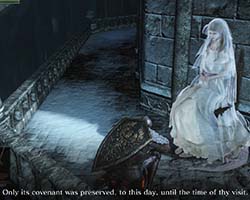
The Blades of Darkmoon should go back
to acting as "bounty hunters".
I don't really have a problem with the Blue Sentinels being a subset of Darkmoons, but I do think that this could be more rigidly enforced within the game. After you meet Yorshka, she should simply replace your Blue Sentinels covenant item with the Darkmoon one (thus "upgrading" you to a full Darkmoon). There's no real reason to have both these items in your inventory. Perhaps this upgrade could require that you turn in a Proof of a Concord Kept to verify that you've acted as a Blue Sentinel? Once you are upgraded to a full Darkmoon, you could then be given the Blue Eye Orb to allow you to invade the worlds of the guilty as a phantom of vengeance. Doing so should probably provide additional rewards (such as an Ember).
Un-tipping the invasion scale
Maybe I'm completely out of touch with regard to this one, but PvP play seems to be extremely heavily in favor of the host. I'm not exactly a pro PvP-er. Far from it. But while I used to be a nearly 50/50 invader in previous games, I'm lucky in Dark Souls III if I can win one in twenty! Despite taking one of my older suggestions to heart and almost eliminating the bar of entry by allowing early access to the Red Eye Orb, FROM has set the skill floor for PvP exceptionally high, leaving Red Eye invasions as something that [ironically] seems more than ever reserved for only the most elite of elite players.
Many of the factors that heavily favor the host in this game are hold-overs from when invaders had the overwhelming advantage of superior equipment and optimized character builds. With that ace-in-the-hole removed, all those mechanics put in place to give invaded hosts a fighting chance have now counter-balanced invasions heavily in favor of the host.
Granting purple and red phantoms the use of their full health bar would be a decent band-aid solution that would put them on equal footing with the host at least. They already have the handicap of reduced Estus, so I don't see any reason why their HP couldn't be maxed. But there are other improvements that could be made as well.
What happened to the smooth online play of DSII and Bloodborne?
I'm not sure what everyone else's experiences were with Dark Souls II and Bloodborne, but I thought that both of those games had wonderfully smooth and fluid online play. I rarely encountered major problems with lag or poor collider boxes while playing PvP in either of those games. This was especially true in Bloodborne, in which almost all of my PvP experiences were enjoyable.
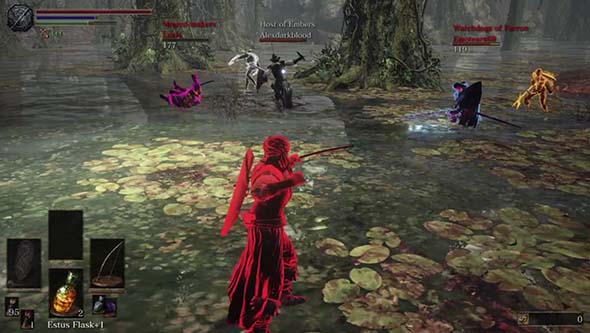
PvP could definitely use some balance and stability improvements.
So it's just that much more annoying that Dark Souls III seems to have such poor netcode. I have consistent issues with apparent lag and latency in Dark Souls III. I'm rarely able to execute a backstab because the host always seems able to roll away, no matter how perfectly I think I've lined it up. Heck, even the backstep command seems useless to me, because every time I try to use it, I end up getting staggered within a phantom hitbox that seems to extend ten feet beyond the edge of the opponent's blade. So far, almost all of the problems that I've had have been while I was invading another player, which just seems to push the odds ever more in favor of the host.
Even out the penalties for invasions versus cooperation
Dying while being summoned to assist another player results in no punishment for the co-operator. Summoned phantoms do not lose their souls or suffer any other death penalties if they die in the host's world. Failed invasions should similarly not result in loss of souls or other penalties. It's already hard enough to have to fight two, three, or four human players, the invader shouldn't be dualy punished by also losing any souls he's collected along the way.
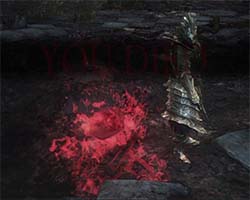
Death as an invader should not be
more punitive than death as a cooperator.
That is, unless cooperating phantoms are changed to suffer death penalties if they die in the host's world! If summoned allies lose their souls by dying in a host's world, then I"d be perfectly comfortable with the idea of an invading phantom similarly losing his or her souls from dying in the host's world. This puts cooperators and invaders on an even playing field in terms of risk versus reward. Either method will grant an ember, and both methods risk losing any accumulated souls.
I prefer the first option. Cooperators and invaders both can fairly easily work around such penalties by just spending their souls before being summoned. If you don't have any souls to lose, then it doesn't matter. The point is that you shouldn't have to manage multiplayer play like that. If spending souls was as easy as sitting at a bonfire (like in Dark Souls 1) that would be one thing, but it's unnecessary to expect players to have to warp to Firelink and then back to the level (sitting through two load screen) in order to clear out their bank of souls before engaging in multiplayer.
Disable "friendly fire" for Red Phantoms
Red Phantoms should not be allowed to hit and damage each other, nor should they be able to hit and damage Farron Watchdogs, Aldritch Faithful, or other invader covenant players. Obviously, Purple Phantoms should remain hostile to everyone. That is - after all - the whole point of the Mound-Makers covenant, and it should not change. But other invading phantoms should not be able to hit each other. The decks are already stacked in favor of the host and his summoned phantoms, and they can already pile on a poor invader with impunity. Invaders should be afforded the same luxury with regard to each other. In the unlikely event that the invaders outnumber the host, they should be able to gang up on him and swarm him, just like the host and his phantoms can gang up on and swarm a single invader.
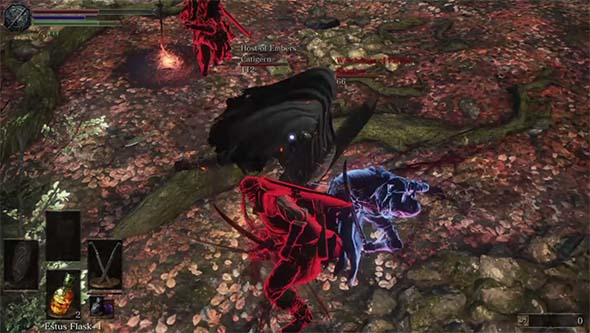
Invading phantoms should not be able to hit each other (except, obviously, for Purple Phantoms).
But, like with the penalties for failed invasions, I'm also open to the idea of going the opposite direction and making the mechanics equally punishing for cooperators. If invaders can all damage each other, then friendly phantoms should be able to deal friendly fire damage to one another as well. It's punishing, but it's fair. Personally, I'd rather see the former option, but I'm open to both; as long as it's equal.
Another possibility could be to reduce the damage dealt when hitting a fellow invader, and maybe even not staggering each other. That way, invaders can still fight each other if they want, but they're less likely to kill each other on accident.